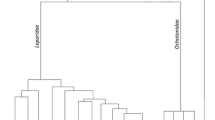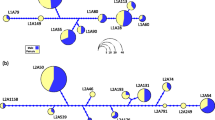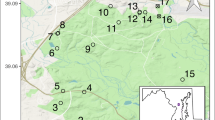Abstract
Two quail lines, H and L, which were developed for high (H) and low (L) antibody production against inactivated Newcastle disease virus antigen, were used to examine differences in the organization, structure and expression of the quail Mhc class IIB genes. Four Coja class IIB genes in the H line and ten Coja class IIB genes in the L line were identified by gene amplification using standard and long-range PCRs and sequencing of the amplified products. RFLP analysis, sequencing and gene mapping revealed that the H line was fixed for a single class IIB haplotype, which we have designated CojaII-02HL-CojaII-01HL. In contrast, evidence was found for two class IIB haplotypes segregating in the L line. Some individuals were found to be homozygous for haplotype CojaII-08L-CojaII-07L and others were found to be heterozygous CojaII-08L-CojaII-07L/CojaII-02HL-CojaII-01HL. However, expression of CojaII-02HL-CojaII-01HL was not detected in the L line. SRBC immunization induced a measurable antibody response in the serum and a line-specific class IIB gene expression in the peripheral white blood cells. CojaII-01HL was expressed at the highest level in the H line and CojaII-07L in the L line. The expression of the class IIB mRNA reached the highest level at approximately 1 week after the primary antibody response and then declined exponentially. The antibody and class IIB gene expression data obtained in response to SRBC immunization provide further evidence that quails within the L line had reduced immunocompetence compared with those in the H line.




Similar content being viewed by others
References
Bacon LD (1987) Influence of the MHC on disease resistance and productivity. Poult Sci 66:802–811
Bourlet Y, Behar G, Guillemot F, Frechin N, Billault A, Chausse AM, Zoorob R, Auffray C (1988) Isolation of chicken major histocompatibility complex class II (B-L) β chain sequence: comparison with mammalian β chains and expression in lymphoid organs. EMBO J 7:1031–1039
Campbell RD, Trowsdale J (1993) The human MHC. Immunol Today 14:349–351
Delany ME, Dietert RR, Bloom SE (1988) MHC-chromosome dosage effects: evidence for increased expression of Ia glycoprotein and alteration of B cell subpopulations in neonatal aneuploid chickens. Immunogenetics 27:24–30
Delany ME, Dietert RR, Bloom SE (1992) The effects of MHC chromosome dosage on bursal B-cell subpopulations in embryonic and neonatal chicks. Dev Comp Immunol 16:313–328
Edwards SV, Hess CM, Gasper J, Garrigan D (1999) Toward an evolutionary genomics of the avian Mhc. Immunol Rev 167:119–132
Gapin L, Bravo de Alba Y, Casrouge A, Cabaniols JP, Kourilsky P, Kanellopoulos J (1998) Antigen presentation by dendritic cell focuses T cell responses against immunodominant peptides: studies in the hen egg-white lysozyme (HEL) model. J Immunol 160:1555–1564
Guillemot F, Billault A, Pourquie O, Behar G, Chausse AM, Zoorob R, Kreibich G, Auffray C (1988) A molecular map of the chicken major histocompatibility complex: the class II beta genes are closely linked to the class I genes and the nucleolar organizer. EMBO J 7:2775–2785
Heller ED, Uni Z, Bacon LD (1991) Serological evidence for major histocompatibility complex (B complex) antigens in broilers selected for humoral immune response. Poult Sci 70:726–732
Hemendinger RA, Putnam JR, Bloom SE (1992) MHC dosage effects on primary immune organ development in the chicken. Dev Comp Immunol 16:175–186
Hess CM, Gasper J, Hoekstra HE, Hill CE, Edwards SV (2000) MHC class II pseudogene and genomic signature of a 32-kb cosmid in the house finch (Carpodacus mexicanus). Genome Res 10:613–623
Hughes AC, Hughes MK (1995) Small genomes for better flyers. Nature 377:391
Inooka S, Takahashi S, Takahashi H, Mizuma Y (1984) Immunological traits in generations to 7 to 12 of two lines of Japanese quail selected for high or low antibody response to Newcastle disease virus. Poult Sci 63:1298–1302
Kaufman J, Volk H, Wallny HJ (1995a) A “minimal essential Mhc” and “unrecognized Mhc”: two extremes in selection for polymorphism. Immunol Rev 143:63–88
Kaufman J, Bumstead N, Miller M, Riegert P, Salmonsen J (1995b) The chicken class II α gene is located outside of the B complex. In: Davision TF, Bumstead N, Kaiser P (eds) Advances in avian immunology research. Carfax, Abingdon, pp 119–127
Kaufman J, Milne S, Gobel TW, Walker BA, Jacob JP, Auffray C, Zoorob R, Beck S (1999) The chicken B locus is a minimal-essential major histocompatibility complex. Nature 401:923–925
Klein J (1986) Antigen-major histocompatibility complex-T cell receptors: inquiries into the immunological menage a trois. Immunol Res 5:173–190
Kulski JK, Shiina T, Anzai T, Kohara S, Inoko H (2002) Comparative genomic analysis of the MHC: the evolution of class I duplication blocks, diversity and complexity from shark to man. Immunol Rev 190:95–122
LePage KT, Bloom SE, Taylor RL Jr (1996) Antibody response to sheep red blood cells in a major histocompatibility (B) complex aneuploid line of chickens. Poult Sci 75:346–350
Lin HK, Bloom SE, Dietert RR (1991) Partitioning of cell surface class II expression and antigen presenting capacity of macrophage in an MHC-gene dosage model. Anim Biotechnol 2:123–143
Lin HK, Bloom SE, Dietert RR (1992) Macrophage antimicrobial functions in a chicken MHC chromosome dosage model. J Leukoc Biol 52:307–314
MHC Sequencing Consortium (1999) Complete sequence and gene map of a human major histocompatibility complex. Nature 401:921–923
Miller KM, Withler RE, Beacham TD (1997) Molecular evolution at Mhc genes in two populations of chinook salmon Oncorhynchus tshawytscha. Mol Ecol 6:937–954
Miller MM, Goto RM, Taylor RL Jr, Zoorob R, Auffray C, Briles RW, Briles WE, Bloom SE (1996) Assignment of Rfp-Y to the chicken major histocompatibility complex/NOR microchromosome and evidence for high-frequency recombination associated with the nucleolar organizer region. Proc Natl Acad Sci USA 93:3958–3962
Munns PL, Lamont SJ (1991) Research note: Effects of age and immunization interval on the anamnestic response to T-cell-dependent and T-cell-independent antigens in chickens. Poult Sci 70:2371–2374
Ohki H, Martin C, Corbel C, Coltey M, Le Douarin NM (1987) Tolerance induced by thymic epithelial grafts in birds. Science 237:1032–1035
Plachy J (2000) The chicken — a laboratory animal of the Class Aves. Folia Biol (Praha) 46:17–24
Qureshi MA, Bloom SE, Dietert RR (1989) Effects of increased MHC dosage on chicken monocyte-macrophage function. Proc Sco Exp Biol Med 190:195–202
Saitou N, Nei M (1987) The neighbor-joining methods: a new method for reconstructing phylogenetic trees. Mol Biol Evol 4:406–525
Salomonsen J, Marston D, Avila D, Bumstead N, Johansson B, Juul-Madsen H, Olesen GD, Riegert P, Skjødt K, Vainio O, Wiles MV, Kaufman J (2003) The properties of the single chicken MHC classical class II α chain (B-LA) gene indicate an ancient origin for the DR/E-like isotype of class II molecules. Immunogenetics 55:605–614
Schat KA, Taylor RL Jr, Briles WE (1994) Resistance to Marek’s Disease in chickens with recombinant haplotypes of the Major Histocompatibility (B) complex. Poult Sci 73:502–508
Shiina T, Hanzawa K, Mizutani M, Watanabe S (1995) RFLP analysis of Japanese quail’s genomic DNA using chicken’s MHC class I probe. Jpn Poult Sci 32:415–419
Shiina T, Shimizu C, Oka A, Teraoka Y, Imanishi T, Gojobori T, Hanzawa K, Watanabe S, Inoko H (1999) Gene organization of the quail major histocompatibility complex (MhcCoja) class I gene region. Immunogenetics 49:384–394
Shiina T, Shimizu S, Hosomichi K, Kohara S, Watanabe S, Hanzawa K, Beck S, Kulski JK, Inoko H (2004) Comparative genomic analysis of two avian (quail and chicken) MHC regions. J Immunol 172:6751–6763
Takahashi S, Inooka S, Mizuma Y (1984) Selective breeding for high and low antibody responses to inactivated Newcastle disease virus in Japanese quails. Poult Sci 63:595–599
Wang JH, Meijers R, Xiong Y, Liu JH, Sakihama T, Zhang R, Joachimiak A, Reinherz EL (2001) Crystal structure of the human CD4 N-terminal two-domain fragment complexed to a class II MHC molecule. Proc Natl Acad Sci USA 98:10799–10804
Westerdahl H, Wittzell H, von Schantz TV (1999) Polymorphism and transcription of Mhc class I genes in a passerine bird, the great reed warbler. Immunogenetics 49:158–170
Zoorob R, Bernot A, Renoir DM, Choukri F, Auffray C (1993) Chicken major histocompatibility complex class II B genes: analysis of interallelic and inter-locus sequence variance. Eur J Immunol 23:1139–1145
Acknowledgements
This work was supported by Grant-in-Aid for Scientific Research on Priority Areas (C) “Genome Science” from the Ministry of Education, Culture, Sports, Science and Technology of Japan.
Author information
Authors and Affiliations
Corresponding author
Additional information
The nucleotide sequence data reported are available in the DDBJ/EMBL/GenBank databases under accession numbers AB110465–AB110482
Rights and permissions
About this article
Cite this article
Shimizu, S., Shiina, T., Hosomichi, K. et al. MHC class IIB gene sequences and expression in quails (Coturnix japonica) selected for high and low antibody responses. Immunogenetics 56, 280–291 (2004). https://doi.org/10.1007/s00251-004-0690-1
Received:
Revised:
Published:
Issue Date:
DOI: https://doi.org/10.1007/s00251-004-0690-1




